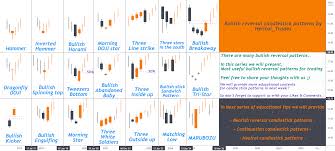Understanding Reversal Candlestick Patterns

Understanding Reversal Candlestick Patterns
Embark on a journey into the fascinating realm of price action analysis as we unveil the secrets behind the art of identifying reversal candlestick patterns. Delve into the world of trading, where precision and intuition intertwine, and uncover how these patterns can help you unlock profitable opportunities in the financial markets.
As the market ebbs and flows, experienced traders know that understanding the language of price can provide valuable insights. Reversal candlestick patterns, with their uncanny ability to foretell potential trend reversals, offer a unique advantage in anticipating market behavior. Through careful observation and interpretation of these patterns, traders open themselves up to a world of endless possibilities.
With this comprehensive guide, we empower you with the knowledge necessary to navigate the labyrinthine landscape of candlestick patterns. Explore the various types of reversal patterns at your disposal, each harboring its own significance and potential outcomes. Armed with this arsenal of information, you will be equipped with the skills needed to make informed trading decisions that can yield substantial returns on investment.
The Basics of Reversal Candlestick Patterns
In this section, we will explore the fundamental principles and concepts behind the intriguing world of reversal candlestick patterns. These patterns, marking significant turning points in price trends, can provide valuable insights to traders seeking profitable opportunities in the market.
Reversal candlestick patterns are a visual representation of market sentiment, capturing the battle between buyers and sellers and offering clues about potential trend reversals. They can indicate shifts in momentum, signaling the possibility of a change in the prevailing market direction.
Understanding the basics of reversal candlestick patterns involves familiarizing oneself with their anatomy and interpretation. Each pattern consists of a combination of candlesticks with distinctive shapes and formations. By analyzing the pattern’s structure, the length and position of the candles’ bodies and wicks, as well as the relationship among neighboring candlesticks, traders can gather valuable information about the market’s future intentions.
Moreover, certain candlestick patterns convey specific meanings and carry different levels of significance. Some patterns, such as the bullish engulfing pattern and the hammer, are powerful signals that suggest a potential bullish reversal. Conversely, patterns like the bearish engulfing pattern and the shooting star indicate the possibility of a bearish reversal.
While reversal candlestick patterns alone cannot guarantee profitable trades, they serve as essential tools in a trader’s arsenal. By combining these patterns with other technical analysis tools and indicators, traders can enhance their ability to identify reliable trade setups with favorable risk-to-reward ratios.
To fully grasp the potential of reversal candlestick patterns, it is crucial to study and practice their identification and interpretation. By doing so, traders can develop a skill set that enables them to navigate the markets more effectively, making informed decisions based on the signals provided by these patterns.
Understanding the Significance of Candlestick Patterns in Price Action Analysis
In the realm of price action analysis, candlestick patterns play a crucial role in determining the future movement of financial markets. These patterns provide valuable insights into the psychology of market participants, allowing traders to make informed decisions and potentially capitalize on profitable trading opportunities.
By studying and interpreting candlestick patterns, traders can gain a deeper understanding of market sentiment and identify potential reversals or continuations in price trends. These patterns are visual representations of the battle between buyers and sellers, capturing the dynamics of supply and demand within a given timeframe.
Each candlestick pattern possesses its own unique characteristics and significance, conveying different messages about the balance of power between buyers and sellers. The presence of bullish or bearish candlestick patterns can indicate potential buying or selling pressure, respectively, and help traders anticipate future price movements.
While there are numerous candlestick patterns, some of the most commonly analyzed and recognized include the doji, hammer, shooting star, engulfing pattern, and evening star. These formations can provide insights into market indecision, potential trend reversals, or the continuation of existing trends.
Understanding candlestick patterns is not merely about memorizing their names or shapes; it is about comprehending the underlying psychology of market participants. This knowledge empowers traders to make calculated decisions based on the information conveyed by candlestick patterns.
However, it is important to note that candlestick patterns should not be relied upon as standalone indicators. They should be used in conjunction with other technical analysis tools and indicators to confirm potential trade setups and minimize risks.
In summary, candlestick patterns serve as a vital component of price action analysis, providing traders with valuable insights into market sentiment and potential future price movements. By understanding and interpreting these pattern formations, traders can enhance their trading strategies and increase their chances of making profitable trades.
Differentiating Reversal Candlestick Patterns from Continuation Patterns
When it comes to analyzing price action in trading, it is crucial to be able to distinguish between reversal candlestick patterns and continuation patterns. Understanding the difference between these two types of patterns can greatly enhance a trader’s ability to identify profitable trading opportunities.
Reversal candlestick patterns indicate a potential change in the prevailing trend. These patterns often occur at the end of an extended uptrend or downtrend and suggest that a reversal is imminent. Traders who can accurately identify these patterns can take advantage of the market’s potential reversal and make profitable trades.
On the other hand, continuation patterns imply that the prevailing trend is likely to continue. These patterns occur during a temporary pause in the market trend and suggest that once the consolidation phase is over, the trend will resume its previous direction. Traders who can differentiate between continuation patterns and reversal patterns can make informed decisions and avoid entering trades that may go against the prevailing trend.
There are various reversal and continuation candlestick patterns that traders should familiarize themselves with. Reversal patterns include the engulfing pattern, harami pattern, and evening star pattern, among others. Continuation patterns, on the other hand, include the flag pattern, pennant pattern, and symmetrical triangle pattern, to name a few.
It is important for traders to carefully analyze price action and candlestick patterns in order to differentiate between reversal and continuation patterns. By doing so, they can increase their chances of making profitable trades and avoid unnecessary losses. Remember, it is crucial to combine candlestick pattern analysis with other technical indicators and fundamental analysis for a comprehensive trading strategy.
Key Reversal Candlestick Patterns Every Trader Should Know
Understanding key reversal candlestick patterns is essential for any trader looking to analyze price action and make profitable trades. These patterns provide valuable insights into market sentiment and can help identify potential turning points in a trend. In this section, we will explore some of the most important reversal candlestick patterns that every trader should be familiar with.
Bullish Engulfing Pattern
The bullish engulfing pattern occurs when a small bearish candle is followed by a larger bullish candle that completely engulfs the previous candle’s body. This pattern suggests a potential reversal from a downtrend to an uptrend. Traders often interpret it as a sign of increased buying pressure and a possible trend reversal.
Shooting Star Pattern
The shooting star pattern is characterized by a small body at the top of an uptrend, with a long upper shadow and little to no lower shadow. It indicates that the bulls initially pushed the price higher, but encountered strong resistance, causing the price to reverse and close near its low. This pattern suggests a potential reversal from an uptrend to a downtrend and may be an indication of selling pressure.
- Hammer Pattern
- Doji Pattern
- Evening Star Pattern
- Morning Star Pattern
These are just a few examples of key reversal candlestick patterns that traders should be aware of. Each pattern has its own unique characteristics and interpretation, so it is important to study and understand them thoroughly. By recognizing these patterns, traders can gain an edge in their analysis and make more informed trading decisions.
Identifying and Analyzing the Hammer and Hanging Man Patterns
In this section, we will explore two powerful candlestick patterns known as the Hammer and Hanging Man. These patterns are commonly used in technical analysis to identify potential reversals in the price trend of a financial instrument. By understanding how to identify and analyze these patterns, traders can gain valuable insights into the market sentiment and make profitable trading decisions.
Hammer Pattern
The Hammer pattern is characterized by a small body at the top of a long lower shadow. This candlestick formation resembles a hammer, hence the name. It signifies a potential bullish reversal after a downtrend, indicating that buyers are starting to gain control in the market.
To identify a Hammer pattern, look for the following characteristics:
- A small real body near the top of the candlestick
- A long lower shadow, at least twice the length of the real body
- Absence or very short upper shadow
When analyzing a Hammer pattern, traders should also consider the overall context of the market, including support and resistance levels, trend lines, and other technical indicators. Confirmation from additional signals can strengthen the validity of the pattern and increase the likelihood of a profitable trade.
Hanging Man Pattern
The Hanging Man pattern is essentially the bearish counterpart of the Hammer pattern. It forms at the top of an uptrend and indicates a potential reversal to a downtrend. The candlestick resembles a hanging man, often with a small real body and a long lower shadow.
To identify a Hanging Man pattern, look for the following characteristics:
- A small real body near the bottom of the candlestick
- A long lower shadow, at least twice the length of the real body
- Absence or very short upper shadow
Similar to the Hammer pattern, traders should analyze the Hanging Man pattern within the broader market context. Paying attention to key support and resistance levels, trend lines, and other technical indicators can help confirm the validity of the pattern and improve the accuracy of trading decisions.
Remember that the Hammer and Hanging Man patterns are just tools that provide potential insights into market sentiment. It is crucial to combine these patterns with other technical analysis techniques and risk management strategies to increase the probability of profitable trades.
Recognizing the Engulfing and Piercing Patterns for Potential Reversals
In this section, we will explore two powerful candlestick patterns known as the engulfing pattern and the piercing pattern, which can provide valuable insights into potential price reversals. By understanding the characteristics and significance of these patterns, traders can enhance their ability to identify profitable trading opportunities in the market.
The Engulfing Pattern
The engulfing pattern is a reversal pattern that occurs when a smaller candlestick is completely engulfed by a larger candlestick in the opposite direction. This pattern signifies a shift in market sentiment, as the larger candlestick is indicative of greater buying or selling pressure. An engulfing pattern that forms after a prolonged uptrend suggests a potential bearish reversal, while an engulfing pattern that forms after a downtrend suggests a potential bullish reversal.
When recognizing an engulfing pattern, it is important to consider the size and color of the candlesticks involved. A bearish engulfing pattern consists of a small bullish candlestick followed by a larger bearish candlestick, while a bullish engulfing pattern consists of a small bearish candlestick followed by a larger bullish candlestick. The larger the engulfing candlestick, the stronger the potential reversal signal.
The Piercing Pattern
The piercing pattern is another reversal pattern that indicates a potential shift in market direction. This pattern occurs when a bearish candlestick is followed by a bullish candlestick that opens below the low of the previous candlestick and closes above the midpoint of the previous candlestick’s body. The piercing pattern suggests that buyers are stepping in and potentially reversing the downtrend.
When identifying a piercing pattern, traders should pay attention to the color and size of the candlesticks involved. The first candlestick in the pattern should be bearish, while the second candlestick should be bullish. The larger the bullish candlestick and the closer its close is to the previous candlestick’s midpoint, the stronger the potential reversal signal.
It is important to note that while the engulfing and piercing patterns can provide valuable insights into potential reversals, they should not be used in isolation. Traders should consider other technical indicators and price action analysis to confirm the signals provided by these patterns. Additionally, proper risk management strategies should be employed to protect against potential losses.
In conclusion, recognizing the engulfing and piercing patterns can greatly enhance a trader’s ability to identify potential reversals in the market. By understanding the characteristics, significance, and proper context of these patterns, traders can effectively analyze price action and make informed trading decisions.
Understanding the Role of Doji Patterns in Reversal Signals
In the world of trading, understanding different candlestick patterns and their significance is essential to making profitable trades. One such pattern that carries significant weight in signaling potential trend reversals is the Doji pattern. This article will delve into the role of Doji patterns in generating reversal signals and explore how traders can leverage these patterns to make informed trading decisions.
Doji patterns are characterized as candlestick patterns with small or no real body, where the opening and closing prices are virtually the same. These patterns represent a state of indecision in the market, as the bulls and bears battle for control. As a result, they often signal potential reversals in the prevailing trend.
There are several types of Doji patterns, each with its own nuances and implications. The most basic type of Doji is the classic Doji, where the opening and closing prices are identical, creating a cross shape. This pattern suggests that the market is in a state of equilibrium and can indicate an impending trend reversal.
- Dragonfly Doji: This Doji pattern has a long lower shadow and no upper shadow, indicating that the price opened and closed at or near the high of the trading session. This pattern is typically found at the bottom of downtrends and can signal a potential trend reversal to the upside.
- Gravestone Doji: Contrary to the Dragonfly Doji, the Gravestone Doji has a long upper shadow and no lower shadow. It suggests that the price opened and closed at or near the low of the session and is often observed at the top of uptrends. This pattern can indicate a bearish reversal.
- Long-Legged Doji: As the name suggests, the Long-Legged Doji has long upper and lower shadows, indicating high levels of volatility and indecision in the market. This pattern represents a tug of war between the bulls and bears and can signal a potential reversal in the prevailing trend.
While Doji patterns alone do not guarantee a reversal, they serve as powerful signals that prompt traders to take a closer look at market conditions. Traders often employ additional technical indicators and analysis to confirm Doji-based signals before initiating trades. By understanding the role of Doji patterns in reversal signals, traders can enhance their ability to spot potential profit opportunities and make more informed trading decisions.
Utilizing Reversal Candlestick Patterns for Profitable Trades
In this section, we will explore the effective techniques to utilize reversal candlestick patterns to maximize profitability in trading. Rather than relying solely on technical indicators or fundamental analysis, reversal candlestick patterns allow traders to harness the power of market psychology and sentiment to make profitable trades.
Understanding Reversal Candlestick Patterns
Before delving into the strategies for utilizing reversal candlestick patterns, it is crucial to have a clear understanding of what these patterns represent. Reversal candlestick patterns are graphical representations of price movement that indicate a potential shift in market direction. These patterns signify a reversal in the prevailing trend, which can be a valuable signal for traders to enter or exit positions.
Identifying and Analyzing Reversal Candlestick Patterns
To effectively utilize reversal candlestick patterns, traders must be able to accurately identify and analyze these patterns. This involves studying the various types of reversal candlestick patterns, such as doji, hammer, engulfing, and shooting star. By recognizing the specific characteristics and formations of these patterns, traders can gain insights into potential market reversals and adjust their trading strategies accordingly.
- Doji patterns: These patterns suggest indecision in the market and can signal a potential trend reversal.
- Hammer patterns: Hammer patterns indicate a potential bullish reversal and are characterized by a small body and a long lower shadow.
- Engulfing patterns: Engulfing patterns occur when a candlestick completely engulfs the previous candlestick, suggesting a potential reversal in market sentiment.
- Shooting star patterns: Shooting star patterns indicate a potential bearish reversal and are characterized by a small body and a long upper shadow.
By studying the formation and context of these reversal candlestick patterns, traders can gain valuable insights into market sentiment and make more informed trading decisions.
Furthermore, it is important to analyze the confirmation signals that accompany reversal candlestick patterns. These signals can include other technical indicators such as moving averages, trendlines, or support and resistance levels. By combining these confirmation signals with the presence of a reversal candlestick pattern, traders can increase the reliability of their trading signals and enhance their profitability.
Implementing Reversal Candlestick Patterns in Trading Strategies
Once traders have mastered the identification and analysis of reversal candlestick patterns, it is crucial to incorporate these patterns into a robust trading strategy. This can involve utilizing the patterns as entry or exit signals, setting appropriate stop loss and take profit levels, and combining them with other technical analysis tools.
It is important to note that while reversal candlestick patterns can provide valuable insights into potential market reversals, they are not infallible. Traders should always exercise proper risk management techniques and consider multiple factors when making trading decisions.
In conclusion, utilizing reversal candlestick patterns in trading can provide traders with a powerful tool for identifying potential trend reversals and maximizing profitability. By understanding how to identify, analyze, and implement these patterns in their trading strategies, traders can gain a competitive edge in the market and make more profitable trades.
Q&A: Reversal candlestick pattern
What is the significance of the “first candle” in a candlestick reversal pattern?
The “first candle” in a candlestick reversal pattern sets the initial trend direction.
Describe the characteristics of a bearish reversal pattern.
A bearish reversal pattern indicates a potential trend change from bullish to bearish and typically chart pattern forms after an uptrend.
How does the “second candle” contribute to a candlestick reversal pattern?
The “second candle” in a candlestick reversal pattern provides confirmation of a potential trend reversal.
What defines a bullish reversal pattern in candlestick analysis?
A bullish reversal pattern signals a possible shift from a downtrend to an uptrend, typically forming after a prolonged decrease in prices.
What elements are considered in analyzing a candlestick chart?
Candlestick charts consider open, high, low, and close prices for a given time period to visually represent price movements.
What are examples of common candlestick reversal patterns?
Common candlestick reversal patterns include the bullish harami, engulfing pattern, and hammer.
How is the “body of the first candle” relevant in candlestick analysis?
The “body of the first candle” represents the price range between the open and close of the first candlestick in a pattern.
Explain the significance of the “body of the second candle” in candlestick reversal patterns.
The “body of the second candle” helps traders gauge the strength and direction of the potential reversal by comparing it to the first candle.
What is a key characteristic of a bullish harami pattern?
A bullish harami pattern consists of a small candlestick (the second candle) within the body of the previous larger candlestick (the first candle), indicating a potential trend reversal.
How does the “third candle” influence the confirmation of a candlestick reversal pattern?
The “third candle” can further confirm the reversal pattern by displaying continued movement in the direction indicated by the first two candles.
What is the significance of a “bullish reversal candlestick” in technical analysis?
A “bullish reversal candlestick” indicates a potential change in trend from bearish to bullish and is often seen as a positive signal by traders.
Describe the characteristics of a “bearish harami” candlestick pattern.
A “bearish harami” is a two-candlestick pattern where a small white candlestick is followed by a larger black candlestick, suggesting a possible reversal from bullish to bearish.
What distinguishes a “white candlestick” in Japanese candlestick analysis?
A “white candlestick” represents a trading day where the closing price is higher than the opening price, often interpreted as bullish.
How do “bullish and bearish” candle patterns differ in their implications for market direction?
“Bullish” candle patterns suggest a potential upward movement in prices, while “bearish” patterns indicate a possible decline.
What is a common characteristic of a “bullish confirmation” candlestick pattern?
A “bullish confirmation” pattern typically features a long white candlestick that follows a smaller bullish candle, strengthening the bullish signal.
Explain the significance of a “bullish abandoned baby” candlestick pattern.
A “bullish abandoned baby” pattern is a three-candlestick pattern that suggests a possible reversal from a bearish trend to a bullish one, often signaling a change in market sentiment.
How does a “black candle” contribute to bearish reversal candlestick patterns?
A “black candle” is a bearish candlestick that closes below its opening price, often signaling a potential reversal from bullish to bearish.
What is the primary characteristic of a “bearish engulfing” candlestick pattern?
A “bearish engulfing” pattern occurs when a larger bearish candle completely engulfs the previous smaller bullish candle, indicating a possible trend reversal to the downside.
How are “candlestick bearish reversal” patterns identified and interpreted?
“Candlestick bearish reversal” patterns are recognized by specific formations on candlestick charts that suggest a potential change from bullish to bearish market sentiment.
Describe the significance of the “body of the second candlestick” in candlestick analysis.
The “body of the second candlestick” provides insight into the strength and direction of the potential reversal, with a larger body indicating stronger momentum towards the reversal direction.






